Seattle-based artist Nikki Frumkin likes to do her work on the go. Her penchant for adventure takes her on multi-day forays into the backcountry in both winter and summer, with a piece of paper and a small watercolor set as her only tools of the trade. This practice allows her to capture the landscapes of the back-of-beyond without the constraints of a traditional studio. We chatted with Frumkin to learn more about her backcountry inclinations and what it’s like to produce art on a multi-day tour. Here’s what she had to say.

Image Title: Enchantment Larches
Backcountry Magazine: Why do you love working with watercolor paints?
Nikki Frumkin: Watercolors have so much movement and translucency. I love the unpredictable qualities of them—they remind me a lot of the landscapes I am in.
I try to make most of my paintings outside, and I have a terrible memory, so if I’m able to take the time outdoors to paint I can really capture the feeling of a place. When I’m back at home, I lose a lot of the life of my work.
I’ve always been a painter, but it wasn’t until I moved to the Pacific Northwest that I started to make watercolor paintings. That’s when I started getting into backcountry travel—hiking, climbing, mountaineering—and skiing as well. These sports were taking up my time, all my weekends. All of a sudden, I realized that I didn’t have time to paint anymore. That’s when I decided to bring watercolors into the backcountry with me. It was an “aha!” moment—that I could bring these two things that I loved together.
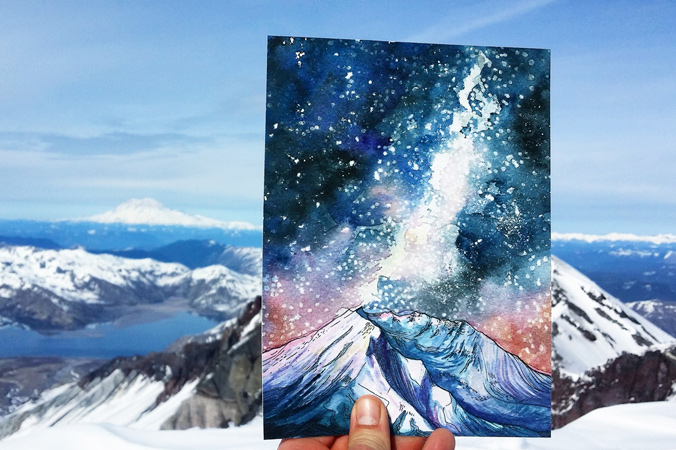
Mount St. Helens painting from summit. [Photo] Nikki Frimkin
BCM: Tell me about how you started to transition to watercolors as an artist.
NF: It was when I started spending all my time in the mountains. My grandmother is a watercolor artist, and she gave me her set of portable watercolors. They turned out to be perfect for painting in remote mountainous places. Watercolors dry super quickly, so I can close my sketchbook and stuff my paper in my backpack when I’m done. When I was still oil painting outside, I always had to be close to a sink or a studio because the oil paints and the things you use with them are really toxic and need to be disposed of properly. That’s not possible when you’re three or four days into the backcountry, so watercolors are perfect. And I really like the chaos and the unexpected nature of watercolors—they create a lot of magic and life.
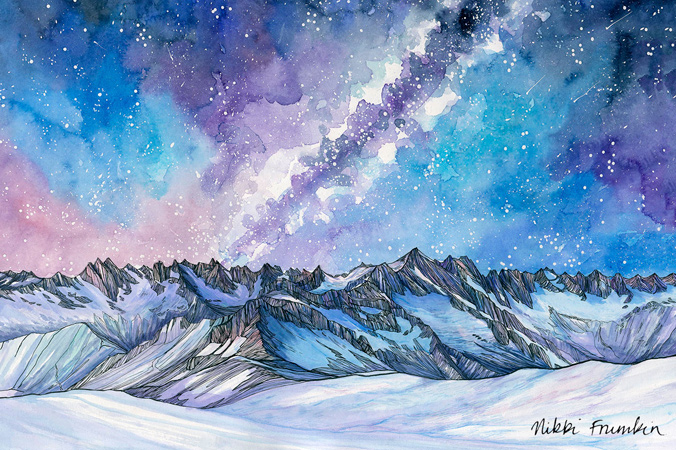
Image Title: Picket Range
BCM: What is your primary mode for getting into the backcountry?
NF: In the winter and spring, it will primarily be on skis—ski touring a bunch. In the summer I’m more of a hiker, backpacker and mountaineer. The Cascades are so rugged, remote, really wild and one of the few parks that doesn’t have a lot of manmade infrastructure. That’s a big draw for me.
BCM: Tell me about why the night sky is such a prominent theme for you.
NF: Until I moved to the Pacific Northwest, I’d never seen the Milky Way or the night sky like I can here in Washington. I’ve lived in New York, right outside the city, so there was a lot of light pollution. When I moved here, it blew my mind that you could see that in the sky, so I started to paint it.
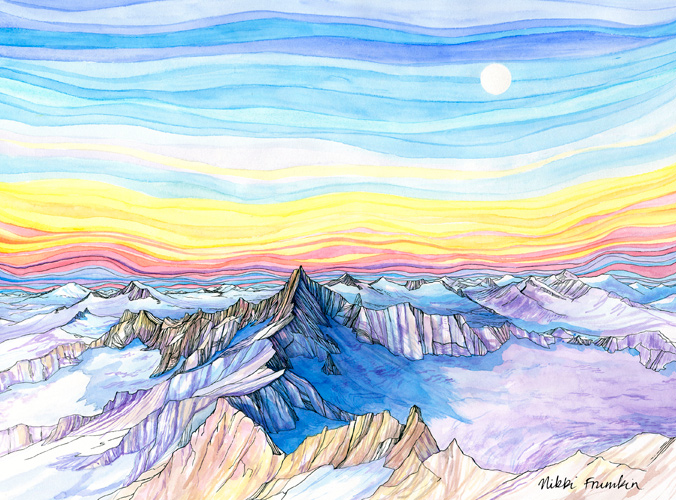
Image Title: Forbidden Peak
But lately I have been doing more sunrises and sunsets, so when I’m out, I try to think about how I can be up in time or stay overnight to see a sunrise—or stay through a sunset. The colors are really beautiful and inspiring, but, also, watching a sunrise or sunset makes me feel like things are falling into place. There’s a lot of hope and space to breathe. It makes me feel like I’m more in tune to the landscape and the sun and the movement of time. And it also means I don’t have to be in the city—it means I can stay out longer.
BCM: How long do you usually head out for?
NF: It really depends. I’ve been doing more solo traveling, so I can decide on my own where I’m going to stay and how long I’m going to be out. Usually the art meets the adventure—so if I know I’m going to be out for a one- or two-day climb with a lot of elevation and not a lot of time for resting, then I’ll probably just bring a small scrap of paper. But if it’s a five-day ski tour with a bunch of winter camping and staying in my tent because of weather, then I bring bigger paper because I can paint for longer. The art is based on the time the adventure allows.
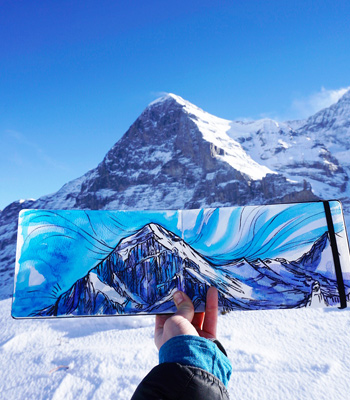
The Eiger North Face. [Photo] Nikki Frumkin
NF: Usually, I’m able to paint during lunch or at camp in the evening—times when I’m not moving. I look around and take in the light and the energy, and I start painting what’s in front of me. I try to capture what the place feels like, in addition to what it actually looks like. A lot of these places are rocks I’ve climbed or glaciers I’ve traveled across, so it’s that balance of me wanting it to look like what it is but also feel like what it is.
BCM: Do you use any techniques to help with that process?
NF: I’ve been using a lot of ink with my watercolors, so those are the black lines mixed in with my watercolors, and I try to use them for movement and emphasis. I think they are really good at capturing how light and wind travels through the mountains.
BCM: How has your art affected how you ski and move through a landscape and, conversely, how has your skiing affected your art?
NF: I‘ve been thinking a lot about art through the lens of risk taking. I sprained my ankle climbing a little while ago, and it wasn’t a major injury, but it took almost a year to heal. I got scared of heights, and I had to figure out how to be in the landscape again. This experience got me thinking about how art forces you to take risks and try new things; otherwise your paintings will be dull and lifeless. I think that risk mindset that has been really great for my climbing and adventure in that it has allowed me to be open to things that I wouldn’t have normally had the opportunity to tackle. And I think that, to me, is art in the mountains. But the other way art affects my mountain experience is that I’ve always wanted to go to the highest point in the landscape and see what’s on the other side to paint it.
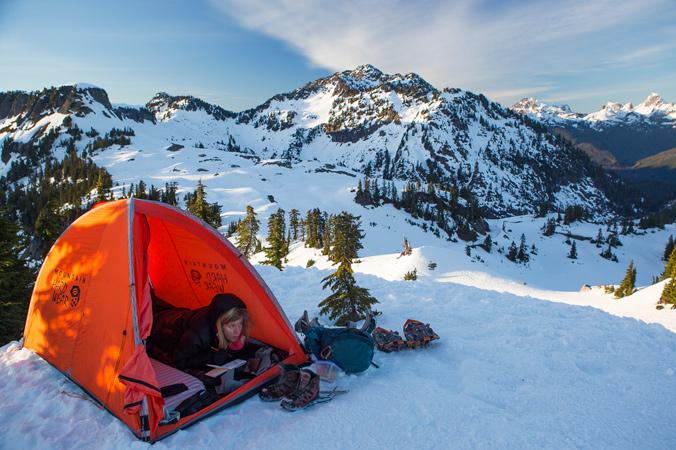
Frumkin takes a break to document her surroundings. {Photo] Shawn Murphy
BCM: How has your art evolved since you started and how do you think it will evolve in the future?
NF: I’m definitely learning all the time, and I love looking back at my old paintings and seeing how much I’ve changed and grown. One of my goals is to keep getting bigger and bigger. I bought paper that’s the size of my bed, and I’ve been taking it with me—rolled and then tied to my backpack—but I haven’t been able to finish something that large outside yet. Usually with my work, I finish everything completely in the moment the scene is happening in, so I really want to capture one moment on this giant piece of paper.
Usually when I ski I try to fit the paper in my pack, but now that I’m tackling these bigger paintings, it has to be strapped to the outside of my pack in a roll. And it’s really interesting to ski and know that I can’t fall because I’ll smush my art. That’s a funny, unexpected twist to my adventures.
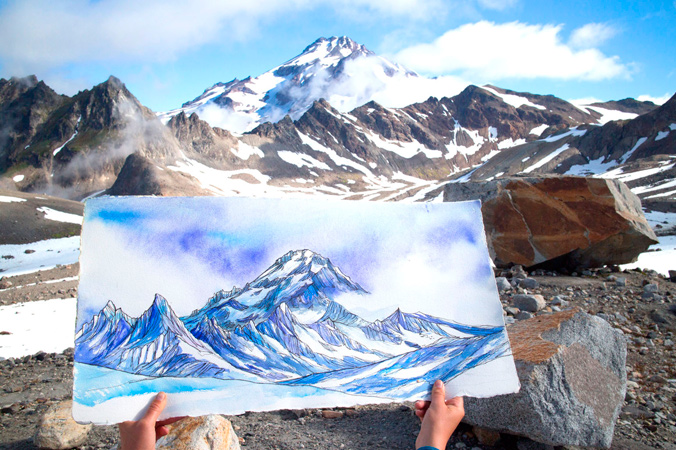
Glacier painting. [Photo] Karen Wang
NF: I hope that when people see my work, they can feel like they know that place or that feeling and it inspires them to get outside and play and care about all of the wonderful shared landscapes we have access to.
—
To view more of Frumkin’s work, visit her instagram feed at www.instagram.com/drawntohighplaces and her website at www.drawntohighplaces.com.










You guys should do @joseph_toney next